Post box
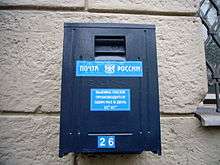
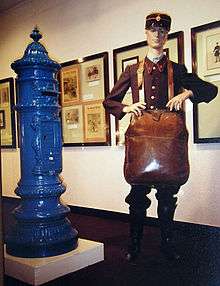
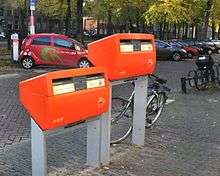
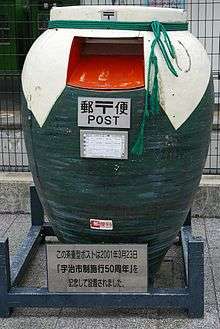
A post box (British English and others, also written postbox; known in the United States and Canada as collection box, mailbox, letter box, or drop box) is a physical box into which members of the public can deposit outgoing mail intended for collection by the agents of a country's postal service. The term post box can also refer to a private letter box for incoming mail.
History of post boxes
Europe
In 1653, the first post boxes are believed to have been installed in and around Paris.[1] By 1829, post boxes were in use throughout France.[2] The first public post boxes in Poland were installed in Warsaw in 1842.[3]
A post box originally installed in the wall of the Wakefield Post Office is dated 1809 and believed to be the oldest example in Britain.[4] It is now on display at the new Wakefield Museum.[5]
In the British Isles, the first red pillar post boxes were erected in Jersey in 1852.[6] Roadside wall boxes first appeared in 1857 as a cheaper alternative to pillar boxes, especially in rural districts. In 1853 the first pillar box in the United Kingdom was installed at Botchergate, Carlisle. In 1856, Richard Redgrave of the Department of Science and Art designed an ornate pillar box for use in London and other large cities. In 1859 the design was improved, and this became the first National Standard pillar box. Green was adopted as the standard colour for the early Victorian post boxes. Between 1866 and 1879 the hexagonal Penfold post box became the standard design for pillar boxes and it was during this period that red was first adopted as the standard colour. The first boxes to be painted red were in London in July 1874, although it would be nearly 10 years before all the boxes had been repainted.[7] In 2012 to celebrate Olympic gold medals for Team GB, selected boxes are painted gold. One has been vandalised briefly with graffiti.[8] One has been painted in the 'wrong' town.[9]
The first public letter boxes (post boxes) in Russia appeared in 1848 in St. Petersburg. They were made of wood and iron. Because these boxes were lightweight and easy to steal, they disappeared frequently; later boxes were made of cast iron and could weigh up to 45 kilograms.
Asia
The post box arrived in the late 19th century Hong Kong and were made of wood. In the 1890s, metal pillar box appeared in Hong Kong and remained in use till the late 1990s. From the 1890s to 1997 the boxes were painted red and after 1997 were painted green.[10]
North America
The United States Post Office Department began installing public mail collection boxes in the 1850s outside post offices and on street corners in large Eastern cities.[11] U.S. collection boxes were initially designed to be hung or supported, and were mounted on support pillars, lamp-posts, telegraph poles, or even the sides of buildings.[11] By the 1880s, these pillar boxes were made of heavy cast iron to deter theft or vandalism.[11] As mail volume grew, the Post Office Department gradually replaced pillar mailboxes with larger free-standing models, though many of the pillar boxes continued in service as late as the 1960s.[11]
The four-footed, free-standing U.S. Mail collection box was first suggested in 1894, following the successful use of such designs in Canada, and quickly became a fixture on U.S. city street corners.[11][12]
Unlike Canadian mailboxes, which were painted red,[13] U.S. mail collection boxes were originally painted in red or green. Beginning in 1909, all mail collection boxes were painted a dark green to avoid confusion with emergency and fire equipment.[11] Dark green gave way to olive drab green after World War I, when the U.S. Army donated a large supply of olive drab green paint to the Post Office. Olive drab green subsequently became the standard color for all U.S. mail collection boxes until 1955. On 4 July 1955, Postmaster General Arthur Summerfield announced that the Post Office would begin painting all mail collection boxes in red, white, and blue to make them easily identifiable. Subsequently, the Post Office began painting mail collection boxes in red and blue, with white lettering.[14][15] In 1971 the Post Office (now USPS) changed mail collection boxes to the current USPS Dark Blue with contrasting lettering.[12][15][16] The coming of the automobile also influenced U.S. mailbox design, and in the late 1930s, an extension chute or "snorkel" to drive-up curbside collection boxes was adopted.[11]
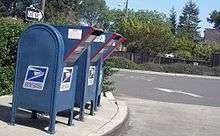

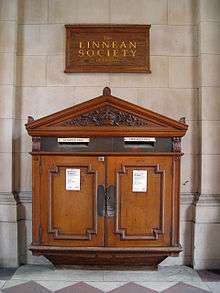
Types of post boxes
Varieties of post boxes (for outgoing mail) include:
Some postal operators have different types of post boxes for different types of mail, such as, regular post, air mail and express mail, for local addresses (defined by a range of postal codes) and out-of-town addresses, or for post bearing postage stamps and post bearing a postage meter indicator.
Some countries have different coloured post boxes; in countries such as Australia, Portugal, and Russia, the colour indicates which type of mail a box is to be used for, such as 1st and 2nd class post. However, in Germany and parts of Sweden, because of postal deregulation, the different colours are for the different postal services. Other nations use a particular colour to indicate common political or historical ties.[17]
Post boxes or mailboxes located outdoors are designed to keep mail secure and protected from weather. Some boxes have a rounded or slanted top or a down turned entry slot to protect mail from rain or snow.[12][18] Locks are fitted for security, so mail can be retrieved only by official postal employees, and the box will ordinarily be constructed so as to resist damage from vandalism, forcible entry, or other causes.[12][18][19] Bright colours are often used to increase visibility and prevent accidents and injuries.[20][21] Entry openings are designed to allow the free deposit of mail, yet prevent retrieval via the access slot by unauthorised persons.[12][22]
Clearance
Post boxes are emptied ("cleared") at times usually listed on a plate fixed to the box. In urban areas, this might be once or twice a day. Busy boxes might be cleared more frequently to avoid overflowing, and also to spread the work for the sorters. Extra clearances are made in the period leading up to Christmas, to prevent boxes becoming clogged with mail.
Since 2005, most Royal Mail post boxes have had the time of only the last collection of the day shown on the box, with no indication of whether the box is cleared at other times earlier in the day. Royal Mail say they needed to increase the type size of the wording on the plate to help those with poor sight, and so there was not enough room to list all collection times throughout the day. Some post boxes may indicate the next collection time by a metal 'tab'[23] or dial that can be changed while the box is open. The tab displays a day or number, each number corresponding to a different time shown on the plate.
Some boxes have been used as a dumping ground for used hypodermic needles.[24] In such cases staff are issued with protective equipment.[25]
Terrorism and political vandalism
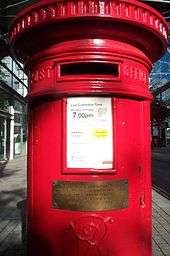
Scotland
In 1952, a number of post boxes were attacked in Scotland in a dispute over the regnal number adopted by Queen Elizabeth II, which was displayed as the EIIR cypher on the boxes. This included at least one which was damaged in Edinburgh with a home made explosive device.
The compromise was to put the Scottish crown on Scottish pillar boxes, without any reference to the particular reigning monarch. One such example can still be seen today in Hong Kong at Statue Square.
The Troubles

During 1939 a number of bombs were put in post boxes by the IRA as part of their S-Plan campaign. When the Provisional IRA blew up the Arndale shopping centre in the 1996 Manchester bombing one of the few things to survive unscathed was a Victorian pillar box dating from 1887 (A type A Jubilee pillar).
In Northern Ireland several red Royal Mail post boxes were painted green by Irish Republicans in early 2009, in order to resemble An Post's post boxes in the Republic of Ireland.[26][27][28]
United States
Nearly 7,000 USPS collection boxes were removed following the aftermath of the September 11 attacks and the 2001 anthrax attacks in which letters containing anthrax spores were placed in public collection boxes. Since that time, a decrease in first-class mail volume and the onset of online bill payment processing has resulted in lower demand for collection box service in the U.S.[11]
Colours

Please help
Symbols
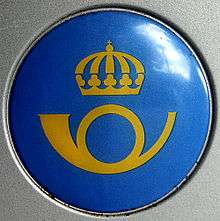
.png)
- Australia – a styled red letter "P" on a white circle, "P" standing for "Post".
- Canada – a combination of a bird wing and an aircraft wing in a red circle and flanked by the words Canada Post / Postes Canada. Previously the words Canada, Canada Post, or Canada Post Corporation) were used on post boxes. Until the early 1970s, post boxes had the words "Royal Mail" and the Royal Coat of Arms of Canada.
- Continental Europe – most designs include a Post horn, like those used by postmen to announce their arrival. In Germany the post horn is the only element indicating post services.
- France – the arrow-shaped logo of La Poste.
- Netherlands – an orange triangle with "postnl" and a royal crown in it.
- Ireland – from 1922 the Irish harp entwined with the letters "SE" for Saorstát Éireann, then "P&T" Gaelic script for Post and Telegraphs and from 1984 An Post with their wavy lines logo, often on the door as a raised casting.
- Russia – logo of Russian Post (Почта России) written white on blue and black on yellow 1st class mail boxes.
- Japan – a "T" with bar above it (〒).
- United Kingdom – all post boxes display the Royal Cypher of the reigning monarch at the time of manufacture. Exceptions are the Anonymous pillar boxes of 1879–1887, where the cypher was omitted, and all boxes for use in Scotland manufactured after 1952 (including replicas of the 1866 Penfold design) which show the Queen's Crown of Scotland instead of the Royal Cypher for Elizabeth II. Private boxes emptied by Royal Mail do not have to carry a cypher. Royal Mail post boxes manufactured since 1994 carry the wording "Royal Mail", normally above the aperture (lamp boxes) or on the door (pillar boxes). Before this date all post boxes, with the exception of the Anonymous pillar boxes, carried the wording "Post Office".
- United States – the United States Postal Service (USPS) eagle logo, except that boxes for Express Mail use the USPS Express Mail logo.
Gallery of post boxes from around the world
 Pillar box in Bruges, Belgium
Pillar box in Bruges, Belgium- Post box in Markham, Ontario, Canada
.jpg) Post box at Dubrovnik Airport, Croatia
Post box at Dubrovnik Airport, Croatia A Czech post box
A Czech post box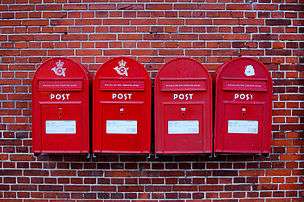
- A post box in Funningur, Faroe Islands
 Post boxes in Heinola, Finland. Orange 2nd class postbox is very common, blue 1st class mailboxes only at selected places.
Post boxes in Heinola, Finland. Orange 2nd class postbox is very common, blue 1st class mailboxes only at selected places. Post box in Galápagos Islands, 1983
Post box in Galápagos Islands, 1983 French Post Box at Ile de Bréhat
French Post Box at Ile de Bréhat French Post Box at Dinard–Pleurtuit–Saint-Malo Airport
French Post Box at Dinard–Pleurtuit–Saint-Malo Airport German mail box with an old Post horn with arrows (stylized lightning bolts) from the Deutsche Bundespost, on the top sign the new post horn from Deutsche Post AG
German mail box with an old Post horn with arrows (stylized lightning bolts) from the Deutsche Bundespost, on the top sign the new post horn from Deutsche Post AG
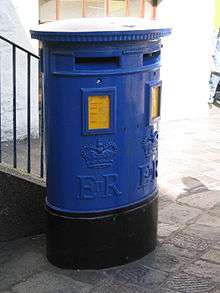 A Guernsey Post type C double aperture pillar box
A Guernsey Post type C double aperture pillar box Singapore AA style sheet metal mail box in Hong Kong
Singapore AA style sheet metal mail box in Hong Kong Post box in Budapest, Hungary
Post box in Budapest, Hungary Post box in Reykjavík, Iceland
Post box in Reykjavík, Iceland Post box mounted on an electric pole in Bangalore, India
Post box mounted on an electric pole in Bangalore, India Post box in Chennai, India
Post box in Chennai, India Post box of Indian Postal Service
Post box of Indian Postal Service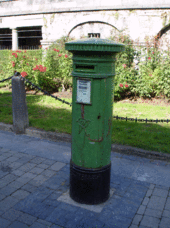
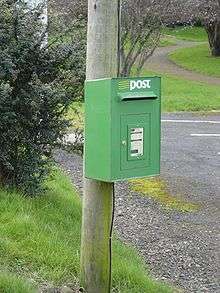
 Italian domestic post box
Italian domestic post box Japanese post box at the Osaka Central Post Office
Japanese post box at the Osaka Central Post Office- Post box in Macau with Chinese and Portuguese texts
 King Edward VII pillar box in Birgu, Malta
King Edward VII pillar box in Birgu, Malta Queen Elizabeth II wall box in Senglea, Malta
Queen Elizabeth II wall box in Senglea, Malta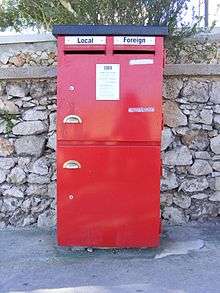 Modern MaltaPost post box in Mellieħa, Malta
Modern MaltaPost post box in Mellieħa, Malta A Polish post box
A Polish post box- Post box in Kraków, Poland
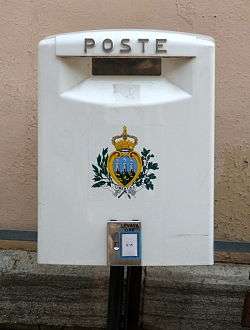 A post box in San Marino
A post box in San Marino Post box in Bratislava, Slovakia
Post box in Bratislava, Slovakia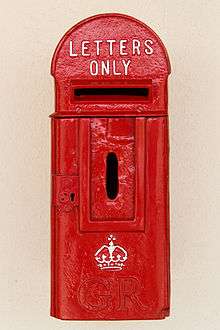 A GR Lamp Box at Cape Agulhas, the most southern post box in Africa
A GR Lamp Box at Cape Agulhas, the most southern post box in Africa Swedish post box
Swedish post box Post box in Lützelflüh-Goldbach, Switzerland
Post box in Lützelflüh-Goldbach, Switzerland- A Ukrainian post box in the city of Dnipropetrovsk, Ukraine
 A standardized Brazilian post box, in Belo Horizonte
A standardized Brazilian post box, in Belo Horizonte
 Post box incorporated into a Type K4 telephone kiosk, introduced in 1927. 10 survive in the UK of this design by Sir Giles Gilbert Scott which also incorporates two stamp vending machines. This red telephone box is in Warrington, Cheshire, England
Post box incorporated into a Type K4 telephone kiosk, introduced in 1927. 10 survive in the UK of this design by Sir Giles Gilbert Scott which also incorporates two stamp vending machines. This red telephone box is in Warrington, Cheshire, England A Victorian wall box of the Second National Standard type dating from 1859, in Brough, Derbyshire, England
A Victorian wall box of the Second National Standard type dating from 1859, in Brough, Derbyshire, England- Post box in Chellaston, Derby, United Kingdom
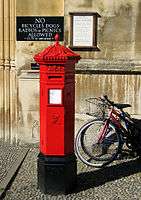 A Victorian hexagonal red post box of the Penfold type manufactured in 1866 outside King's College, Cambridge (not the original location for this box).
A Victorian hexagonal red post box of the Penfold type manufactured in 1866 outside King's College, Cambridge (not the original location for this box). One of the 150 post boxes erected during the uncrowned reign of Edward VIII
One of the 150 post boxes erected during the uncrowned reign of Edward VIII British Edward VII Type A pillar box of 1902 by A.Handyside of Derby in front of Mansfield College, Oxford
British Edward VII Type A pillar box of 1902 by A.Handyside of Derby in front of Mansfield College, Oxford- US post box in front of the Post Office in Conneaut, Ohio
 Bukhara, Uzbekistan
Bukhara, Uzbekistan post boxes in Taipei, Taiwan
post boxes in Taipei, Taiwan A standard British lamp letter box mounted on a post in Menai Bridge, Anglesey, Wales
A standard British lamp letter box mounted on a post in Menai Bridge, Anglesey, Wales Large square pillar box (type A wall box freestanding) in Gloddaeth Street, Llandudno, Wales
Large square pillar box (type A wall box freestanding) in Gloddaeth Street, Llandudno, Wales
See also
- General Post Office
- Post-office box, used for incoming mail
- Stamp vending machine, often attached to post boxes
- United States Postal Service
- 2012 Olympics gold post boxes in the United Kingdom
References and sources
Notes
- ↑ Lawrence, Ken. "Before the Penny Black". Ken Lawrence. Retrieved 15 August 2008.
- ↑ Batcow, Stan (2 December 2001). "The Post Boxes of Blackpool, England". Retrieved 15 August 2008.
- ↑ Hampel, Tadeusz (1993). Encyklopedia filatelistyki. Warszawa: Wydawnictwo Naukowe PWN. p. 509. ISBN 83-01-11373-1.
- ↑ "Putting history on an envelope". London: BBC News South West Wales. 18 August 2009. Retrieved 8 August 2012.
The earliest known surviving posting slot was placed in the wall of Wakefield Post Office in Yorkshire in 1809
- ↑ "BBC Slaithwaite gets the stamp of approval!". Bbc.co.uk. 24 August 2012. Retrieved 9 May 2014.
- ↑ Barford, Vanessa (2 March 2012). "BBC News – Are there places more British than the UK?". Bbc.co.uk. Retrieved 10 March 2013.
- ↑ Wicks, Paul (2002). "History of British Letter Boxes – Part 1: Victorian Letter Boxes". Paul Wicks. Retrieved 15 August 2008.
- 1 2 "BBC News – Jessica Ennis gold postbox in Sheffield vandalised". BBC Online. 8 August 2012. Retrieved 8 August 2012.
A postbox that was painted gold in Jessica Ennis's home city of Sheffield, to celebrate her Olympic triumph, has been vandalised.
- 1 2 "BBC News – Laura Trott golden postbox painted in Harlow by mistake". BBC Online. 8 August 2012. Retrieved 8 August 2012.
The Royal Mail has promised to paint a postbox in Olympic cycle champion Laura Trott's home town gold, after first painting one in the wrong place.
- ↑ https://www.hongkongfp.com/2015/10/05/hongkong-post-to-cover-royal-cyphers-on-59-historic-post-boxes/
- 1 2 3 4 5 6 7 8 Marsh, Allison (20 March 2006). "Postal Collection Mailboxes". National Postal Museum. Retrieved 15 August 2008.
- 1 2 3 4 5 Shaman, Tony. "Antique Street Letterboxes". Antique67.com. Retrieved 16 August 2008.
- ↑ Canadian Museum of Civilization Corporation, History in a Box: Red Forever!, Civilisation.ca. http://www.civilisations.ca/cpm/histbox/canad_e.htm
- ↑ U.S. Post Office Bulletin 19867, 9 August 1955
- 1 2 Marsh, Allison; Pope, Nancy (28 April 2006). "Orr & Painter mailbox". Postal Collection Mailboxes. National Postal Museum. Retrieved 16 August 2008.
- ↑ United States Postal Service v. Lost Key Rewards, Inc., U.S. Patent and Trademark Trial and Appeal Board, Opposition No. 91185802 (15 November 2010), retrieved 23 January 2012
- ↑ Canadian Museum of Civilization Corporation, Colour, A Postal Symbol, Civilisation.ca. http://www.civilisations.ca/cpm/histbox/couleu_e.htm
- 1 2 Glancey, Jonathan (16 January 2007). "Classics of everyday design No 6". theblog. The Guardian. Retrieved 16 August 2008.
- ↑ Marsh, Allison (29 April 2006). "Street collection box damaged September 11, 2001". Postal Collection Mailboxes. National Postal Museum. Retrieved 15 August 2008.
- ↑ "A Victorian post box in Brecon – made in the Black Country". Black Country Bugle. 28 June 2007. Retrieved 15 August 2008.
- ↑ "Campaign to preserve red post boxes". BBC UK News. BBC. 3 October 2002. Retrieved 15 August 2008.
- ↑ William, Earle (29 April 1975). "Secured mailbox". USPTO Database. USPTO. Retrieved 16 August 2008.
- ↑ "Changes to post box collections: Collection Tabs". Postwatch.co.uk. Archived from the original on 30 June 2007. Retrieved 15 August 2008.
- ↑ "Used needles found in post boxes". BBC Online. 17 October 2008. Retrieved 6 January 2013.
Postal workers in Derby are being warned to take care after a rise in the number of used syringes being found in post boxes.
- ↑ "BBC News – Somerset postal workers given gloves to protect against needles". BBC Online. 4 January 2013. Retrieved 6 January 2013.
Protective gloves are issued to postal workers emptying a Somerset postbox used by drug addicts to dump needles.
- ↑ Quinn, Louise (4 February 2009). "Green postbox row MLA told to say sorry". Belfast Telegraph. Retrieved 20 April 2012.
- ↑ "Anger over green postboxes". Belfast Telegraph. 10 November 2010. Retrieved 20 April 2012.
- ↑ "Seeing red on green postboxes". Derry Journal. 10 September 2008. Retrieved 20 April 2012.
- ↑ All Royal Mail / GPO post boxes were painted BS 538 Post Office Red between 1874 and 1969. With the introduction of the K8 Telephone kiosk in 1969, a new "red" colour was adopted for GPO street furniture, designated BS 539 Post Haste Red. After British Telecom and Royal Mail were split by the British Government, BT continued to use BS539 exclusively, whilst Royal Mail use both BS538 and BS539 in a seemingly random way. Prior to 1859 there was no standard colour although there is a document in the BPMA archive indicating that optionally, the lettering and Royal cypher could be picked out in white or black. In 1859, a bronze green colour became standard until 1874. It took ten years for every box to be repainted during this period).
- ↑ In 2012 UK post boxes mostly in the hometowns of Team GB gold medal winners in the 2012 Summer Olympics were painted gold.
- ↑ PIN MAIL AG
Sources
Farrugia, Jean (1969). The letter box: a history of Post Office pillar and wall boxes. Fontwell: Centaur Press. p. 282. ISBN 0-900000-14-7.
External links
| Wikimedia Commons has media related to Post boxes. |
| Look up post box in Wiktionary, the free dictionary. |
- Letter Box Study Group
- Post Boxes of Oxford
- British Postal Museum & Archive
- Colne Valley Postal History Museum
